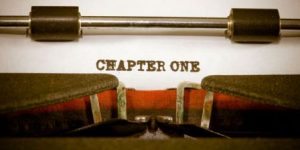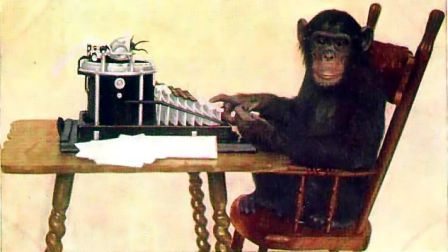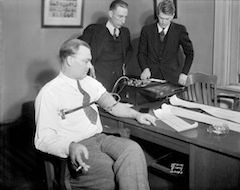-
Alcatraz
The California island fortress prison is infamously known for its legendary inmates and escapes, but it’s also a prime point for practitioners of the paranormal. Several ghost stories originate from these walls, including the tale of 14D, where an inmate once reported that a creature with glowing eyes would kill him during the night. His screams were unanswered, and by morning, he was strangled to death. No one ever took credit for the man’s death. The prison also boasts the ghost of Al Capone, playing his banjo from inside the thick stone walls.
-
Mansfield Reformatory
Opened in Ohio in 1896, the Mansfield Reformatory (closed in 1990) boasts many haunted sites inside its prison walls — the administration wing, the chapel, the infirmary, several cell blocks, and the basement are all said to be haunted. The spirit of a 14-year-old who was beaten to death is said to haunt the basement, and many visitors complain of overwhelming nausea after a visit to “The Hole,” the solitary chamber where many prisoners died during Mansfield’s years as a functioning prison. The site was the subject of Haunted Investigators‘ first show. You can’t get more spooky than that!
-
Eastern State Penitentiary
Philadelphia’s Eastern State Penitentiary is said to be one of the most haunted places in North America. Quakers originally ran the facility, and wanted the inmates to have few distractions in an attempt to bring them to God. The truth is more like inhumane punishments and crazy-making solitude. Famously, a locksmith working to break a 140-year-old lock in Cell Block #4 was so overtaken by negative spirits that he spoke passionately of the experience for the rest of his life.
-
Tower of London
The Tower of London is perhaps Britain’s most famously haunted structure, and the site boasts an extremely bloody past. The tower, which was a prison for ne’er-do-wells and nobles alike (as well as home, for a time, to the Royal Menagerie of zoo animals), played host to years of torture, grisly beheadings, and many murders. Anne Boleyn was famously beheaded there by Henry VIII, and her ghost is said to haunt the tower still. Thomas A. Becket, Sir Walter Raleigh, and the feisty Countess of Salisbury have all been reported as paranormal figures in the tower, and the spooky reputation has made the structure one of London’s top tourist traps.
-
Moundsville
The Moundsville Penitentiary of West Virginia opened in 1876, and in its 110-year history came to be known as one of the bloodiest sites in American history. Violence, harsh punishment, and suicides occurred on its grounds, but poor recordkeeping makes it impossible to know the exact number of souls stamped out at Moundsville. The prison housed several Gothic-style torture devices, and its dismal past makes this prison a favorite destination of ghost hunters. The chapel, the showers, and death row are particularly known for being hotbeds of paranormal activity.
-
Stateville
Stateville Correctional Center in Crest Hill, Ill., is one of the many places executions were carried out by electrocution in the 20th century. John Wayne Gacy, one of the country’s most extreme serial killers, was executed within Stateville’s walls. The prison uses a panopticon concept, a circular building with an observation post at the center reminiscent of utilitarian philosopher Jeremy Bentham. Proximity to Joliet and scary stories from locals (who call the place “hell on earth”) have prompted many ghost stories and much speculation about the prison, which is currently still in use. A prison-themed haunted house is a major attraction of the area.
-
Joliet
This Illinois prison is near Stateville, and it looks more like a Gothic castle than a penitentiary. Joliet was home to Civil War POWs and criminals alike, and was closed in 2002. The famous prison was featured in Blues Brothers, but that’s not what makes people curious about what went on inside Joliet’s walls. Executions were performed there, and stories of a hitchhiker named Mary and singing ghosts have long captured the imagination of both locals and worldwide ghost seekers.
-
The Clink
Home to more than just the nickname, the Clink Prison in London is now a museum. Dating back to 1144, the penitentiary is perhaps the oldest organized jail in England’s history, leaving it ripe for many a haunting. One corner of the museum has had upwards of 50 reports of a woman prisoner seated, playing with chains. The historic institution and museum sit on the site of the old prison, and no mere mortal or ghost hunter is safe from paranormal activity within its walls.
*Today’s article by www.thebestdegrees.org
Google+ still has yet to firmly seize the social media sector, but the digital overlords have obviously started experimenting in ways to keep its offerings as fresh and unique as possible to set themselves apart from Facebook and Twitter. The relatively new Hangouts feature serves as a group video chat where friends, family, professionals, classrooms, cam fetishists, and hobbyists across the globe can meet and discuss anything they desire. Even the early adopters still fiddle with the feature in order to use it to its fullest potential, but many past, present, and future events already started building up in the bibliophile community. They aren’t easy to find, and they’re sometimes rather sporadic, but the following Hangouts showcase how many Google+ users choose to harness the available technology. Watch the archives, join in regular meetings, and get inspired about ways to promote and share literary love.
-
Books & Beer:
ePublish Unum — Digital Author Education often hosts Books & Beer live hangouts with Lynette Young and J.G. Hutchins, where they talk about issues relating to self-publishing. Check with the organization’s profile for information about when the latest event will take place.
-
Christopher Moore:
Nook hosted a hangout promoting author Christopher Moore’s new novel Sacre Bleu, allowing some lucky fans to ask him questions via video chat and learn about his writing process and the ins and outs of the book. And, of course, his plans for any future reads joining such established comedic classics as Fool and Lamb.
-
Vaginal Fantasies:
Actress Felicia Day heads up a digital book club catering to women who enjoy discussing the fantasy genre in a fun, light, and sassy setting. It meets every month, so stop by her Google+ profile for information about the next scheduled hangout.
-
Brandon Sanderson:
This author has taken over the beloved Wheel of Time series following the passing of Robert Jordan, and Google Australia allowed fans and fellow writers to meet with him and talk shop. Eager comments and questions about where he plans to pick up abound in both the discussion itself and the comments section following it.
-
All About Book Promotion with Aggie Villanueva:
Perfect for authors wanting to learn more about getting readers interested in what they have to say, the pilot to this possibly ongoing hangout series covers promotional strategies both digital and traditional. Google+ video chats seems to be gaining some semblance of popularity among writers looking for a way to get up close with potential and established fans.
-
Nicholas Sparks:
An adaptation of novelist Nicholas Sparks’ The Lucky One recently hit movie theaters, and he agreed to a Hangout session to dish on watching another one of his books on screen. The story involves a young soldier in Iraq whose fateful find of a lovely young lady’s photo keeps him going through three tours of duty.
-
The Oxford Book Club:
Because this online literary organization does not post its recorded meetings online, hopeful participants should circle its profile to find out about the month’s selections and scheduled times. Past picks include novels The Man Who Mistook His Wife for a Hat and The Sense of an Ending.
-
SciLingual:
Lovers of all things scientific and literary — particularly their intersections! — should give this union of the two disciplines a circle. They post frequently about upcoming hangouts with the authors in question and cover a wide range of different scientific areas of study.
-
Google Hangout with Jason and AC:
Every week, these two writers get indie with it and discuss books and publishing subjects relevant to authors and readers alike — particularly those into small presses and self-printed-and-promoted reads. Guests pop in and offer their own insight and advice on marketing, going digital, and plenty more.
-
Hangout Conversations:
Host Michael Rappaport brings on “sit-down comedian” Glenn Rogers to chit-chat about two different writing formats, blogging and e-books, which new media buffs will obviously find worth delving into. Even those without any sort of literary leanings might enjoy the pop culture riffs and opines regarding video games.
*Today’s article by the staff writers at www.onlinecollegecourses.com
Making it as a writer can be hard, no matter what kind of writer you aspire to be. That’s why it’s so important to reach out to other writers and people in the publishing industry to learn all you can, get support, and gain an understanding of how the business works. One of the best places to do that is on LinkedIn, and with the plethora of groups hosted by the site it’s easier than ever to build a seriously great network of those in the industry. If you’re not sure where to start, use these groups as a starting place. They’ll help you make connections and get valuable feedback on your work that can help you get started making a career as a writer.
- LinkEds & Writers: With more than 36,000 members, this is one of the biggest groups on LinkedIn for writers, proofreaders, and editors. It’s so big that there are several subgroups, each dedicated to a different specialty, making it easy to connect with those who work in a field you find interesting.
- Books and Writers: If you’ve got some writing you’d like to market or show off to publishers or other authors, then give this group a try. It caters to those who are looking to network and promote their work as writers.
- Affiliated Authors: Head to this group to promote your writing, meet others who publish and write books, and to learn just what it takes to make an idea a success.
- Authors, Writers, Publishers, Editors, & Writing Professionals: This group is for publishing professionals, which can make it a great place to learn more about how the industry operates. While you can’t use it to find yourself an agent or advertise your writing, it can be a highly enlightening forum for those who are truly new to the ins and outs of the publishing world.
- The Freelance Writers’ Connection: Have you ever considered working as a freelance writer? Check out this group to learn more about what it means to be a freelancer, and all the pros and cons that come along with it.
- Published Authors Network: You may not be a published author yet, but that shouldn’t stop you from checking out this open group. In it, you’ll find loads of advice and discussions on everything from finding a literary agent to budget-friendly book promotion.
- Iconoblast Writer’s Group: Head to this group to showcase your writing, meet up with other aspiring authors, and find some support for the often difficult parts of being a writer.
- Informed Ideas for Writers: Those looking for ideas on how to become a better writer, the present and future of the writing industry, or just a few writing prompts should join this group for a bit of guidance.
- Writers: Writers is a fairly large group that focuses on helping writers, both new and seasoned, get feedback on their writing. It’s a great place to meet people in the creative industries, as well as to get some tips on polishing your work.
- Fiction Writers Guild: If fiction is your favorite, then don’t miss out on the discussions held on this group. You’ll find loads of discussions on just about everything writing-related, including grammar, self-publishing, writer’s block, promoting your book, and more.
- Aspiring Writers: An obvious choice for aspiring writers, this group caters to those who are still trying to make it in the industry. Members share tips, advice, blogs, and much more as they work to help each other improve their work and get ahead.
- The Writers’ Network: Aspiring writers and those who are more established both frequent this group, as well as editors, agents, and others in the publishing business, making it an all-around great place to network.
- Writers International: Why just connect with writers in the U.S. when you can go global? This group will help you make connections with writers and literary enthusiasts from all around the world.
- Writers World: This group is home to writers who share their experiences, trips, suggestions, and questions, and writers at any level of experience are welcome. Even better, the group encourages shameless self-promotion.
- Authors & Publishers Association: Head to this group for authors, publishers, book manufacturers, agents, publicists, editors, and others in the literary trades to find some amazing discussions on all things writing-related.
- Writers and Authors Circle: Whether your work is published or not, the group encourages you to join up and start chatting with other authors.
- Nonfiction Authors Network: Not really into writing fiction? No worries, LinkedIn has you covered. This group is focused on nonfiction reads, allowing you to meet and get help from other authors, and you can promote your projects as well.
- Booksconnect: Get inspired to create an amazing book when you check out this group. It features articles and discussions that are sure to get you feeling creative. Even better, you can network with other writers at the same time.
- Authors and Writers: Share ideas, network, get feedback, and just learn more about writing from the members of this group, dedicated to sharing a passion for all things literary.
- Authonomy’s Aspiring Writers’ Group: Here you’ll find another group dedicated to aspiring writers, hosted by the website Authonomy (which is also a great place to discuss writing). It’s a casual, intimate place to meet other writers and get help with your work.
*Today’s article by www.onlinecollegecourses.com
If you’re tired of your Moleskine and think that Microsoft Word is for laughable tech dinosaurs, consider going mobile with your writing. With non-verbal communication becoming the norm in today’s fast-paced, tech-forward world, there are many new tools designed to help you get the most out of your writing time, and, indeed, your words. If you’re struck with inspiration when you’re on the go, at least one of these eight essential apps should be available at your fingertips. Beware, wannabe writers! Once you’ve downloaded any or all of these tools, you’ll have less of an excuse to say that you “just can’t find the time” to write. For professionals and amateurs alike, these eight mobile-friendly writing apps are great assets to your toolkit.
-
Clean Writer
With all the clutter and noise out there keeping you from doing your best writing, there exists an app that silences all red underlines and dings until the time is
writeum, right. Boasting a “clean” user interface, “intuitive workflow,” and hidden editing options that only show up when you’re ready, Clean Writer is good for both beginning and advanced mobile writers. If you’ve got ideas to map and brainstorming to do, Clean Writer is an easy and functional tool for keeping yourself both organized and optimized. -
Pages
It’s an industry standard, and there’s no question why. If you already use the word-processing application on your desktop Mac, you’ll be ready to go mobile with Pages in no time. The no-frills word processor allows for distraction free writing, and has cross-platform functionality that makes it truly a writer’s greatest tool.
-
Story Tracker
Story Tracker is an app that keeps track of your story submissions and pitches, and it’s a great tool for professionals and amateurs alike. Available in both paid and free versions, the creator of the app is intimately involved in transparently tracking sales, usage, and responding to feedback with important functionality updates. With the exception of guaranteeing that you’ll soon see your name in lights (or, in print, as it were), there’s not much you can’t do (or find help with) if you’re using Story Tracker.
-
Advanced English Dictionary and Thesaurus
Developed by the Cognitive Science Laboratory at Princeton, the Advanced English Dictionary and Thesaurus is a truly useful little app with a long name. Search for synonyms to break up writing monotony and improve your working vocabulary, and have a go at defining one of almost 150,000 included English words. Bust writer’s block and the diction doldrums by utilizing this invaluable, free tool of the trade, and do so from anywhere that your writing (or your life) might take you.
-
B-Rhymes
Who says all writers have to go pro(se)? For the nascent poet (or rapper) in you, get your hands on the free B-Rhymes rhyming dictionary app. B-Rhymes rocks because it doesn’t stick to a strict script — the app chooses words that “almost” rhyme with entries, providing you more creative freedom when you’ve got syllabic sounds to work around.
-
ScriptWrite
You could be the first award-winning screenwriter to pen a piece from your phone. Download ScriptWrite for $3.99, and easily write and format scripts by industry standards. The visual interface that tops the touch-screen keyboard makes it easy to include stage direction and dialog, and you don’t have to spend hours at a typewriter to get the right spacing effect. Budget-conscious customers (read: starving artists) prefer ScriptWrite to the insanely popular First Draft, as its software updates are free (and there’s a great mobile interface), unlike its big-timin’ predecessor.
-
Grammar App HD
If you need a refresher course on your grammar rules (you probably do), the internal tests in this $0.99 app can help you back to tip-top shape in no time. If you can’t pen your projects while using proper grammar, it’s likely that you’ll never find meaningful work as a writer. Journalists, grad students, and casual writers alike boast satisfaction with this highly interactive product, and it’s likely that even the most stringent grammarians still have a little something to learn.
-
iA Writer
iA Writer for iPad is brought to you by the lovely folks at Information Architects, and they’ve truly created the most beautiful writing app out there. While you can download a version of this for your mobile device, the true value of iA Writer is best viewed on an iPad. Another application known for distraction-free writing, the touch-screen tools (such as Focus Mode and One Tap Renaming) are truly where the difference in well-designed functionality lies.
*Today’s article by www.onlineclasses.org
*We are back home today, so the blog should be back to normal tomorrow (however, my definition of normal may differ greatly from yours). Thanks for your patience.
Just about everyone and their mother (especially mothers) is on Pinterest these days, and we can’t blame them: it is a really cool resource for finding the very best ideas, inspiration, and all around neat stuff. So we are not at all surprised to find out that colleges and college students are joining in on the fun, too.
Many colleges and universities have jumped on Pinterest to create their own boards for prospective and current students, alumni, and other interested parties, and lots of them are doing a really great job. From game day fashion to alumni baby photos, college pinboards are full of some really fun and useful stuff. Read on, and we’ll share 20 of the college Pinterest boards that we’re most impressed with.
-
Adorable bulldogs
Drake University is doing great things with their Pinterest account, including Celebrate Drake, Study Abroad, Ultimate Fan, and Bulldogs Without Borders boards that are truly outstanding. Our personal favorite is one that highlights photos of bulldogs, Drake’s official mascot. This is a really fun and lighthearted way to bring school spirit to Pinterest.
-
Future Aggies
We’re big fans of the way that Texas A&M makes being an Aggie a family affair. In their Future Aggies Pinterest board, TAMU shares cute clothes, baby photos, and a celebration of everything that Texas A&M kids might like.
-
Famous Maryland Alumni
The University of Maryland makes their educational value stand out by highlighting alumni that have gone on to make it big. The school boasts graduates including Google’s Sergey Brin, Connie Chung, and Jim Henson, fun facts that we were oblivious to before Pinterest.
-
Eat for $5
Obviously catering to the poor college crowd, Multnomah University’s Eat for $5 Pinterest Board shares great eats that students can pick up for a fiver or less. Have a little more wiggle room? They’ve got a board for $10 meals and even $10 Portland activities.
-
Bikes & Bike Style
On the bike-friendly campus of Oberlin College, two-wheeled love doesn’t stop on the bike paths: it goes on Pinterest, too. Cool bikes, inspiring bike style photos, and even great ideas for never losing your bike key again are available through this college pinboard.
-
Flip Flops & Long Boards-Campus Style
California Baptist University embraces California style in this pinboard. Check out Flip Flops & Long Boards to find cool dorm ideas, shoe styles, and even rad skateboard designs.
-
Weekend Adventures
Stockton College has found a great way to motivate students, highlighting awesome adventures that they can look forward to each weekend. With a location that puts students close to the beach, Atlantic City, Philadelphia, and even New York City, Stockton’s collection of weekend adventures on Pinterest is impressive.
-
The Treasures of Yale
On Pinterest, Yale is able to highlight some of the most amazing artifacts in the university’s collection, posting videos in The Treasures of Yale. This video series and Pinterest board goes in depth to explore arts, humanities, and science treasures from Yale, including rare paintings and art pieces.
-
Nowhere Like Here
In this Pinboard, Bennington College does a great job of highlighting what makes their school unique. Photos of interesting spots on campus, unique activities, Bennington-only moments, and cool projects make this college look like a place you want to be.
-
William Woods, the man
Dedicated to the namesake of William Woods University, this Pinterest board has photos of Dr. William Stone Woods, as well as photos of his gravesite. We really enjoy the way that William Woods University celebrates its heritage here on Pinterest.
-
Global Like No Other
Although some colleges might say they offer a global education, Concordia College really backs it up with this Pinterest board. Through links, photos, and stories, the Global Like No Other board from Concordia offers extensive proof of why this school regularly ranks among the top 15 colleges in the country for global study.
-
Historic Boston
As a women-centered university located in Boston, Simmons College has a lot to offer when it comes to the history of the city. Old photos, maps, and historic architectural projects can be found in the college’s Historic Boston pinboard.
-
Jobs, Careers, & Internships
We’d like to see Folsom Lake College really explore all that Pinterest has to offer, but their Jobs, Careers, & Internships pinboard is off to a great start. Sharing relevant articles, news, and even the latest job openings, Folsom’s pinboard is a great resource for students to check out.
-
True love
Sometimes, true love happens on a college campus. This is evident at Illinois College, and they’ve dedicated an entire pinboard to highlighting Illinois College sweethearts, married couples who met and developed their relationships at the college. Newlyweds, families, and old married couples contribute to this pinboard’s warm and fuzzy feeling.
-
People of Elizabethtown College
Just who makes up Elizabethtown College? This pinboard offers an answer, sharing links to stories about students, alumni, faculty, staff, and others in the Elizabethtown community. We love how Elizabethtown offers this pinboard to help outsiders get an idea of what the college is all about.
-
Things to do at Carleton
We’re sure there’s no shortage of things to do at Carleton University, and this pinboard does a great job of pointing out several of the fun activities that the school has to offer. Through Things to do at Carleton, students and other interested parties can learn about art galleries, talent events, a butterfly exhibit, and even a magic show.
-
Maymester Destinations
Students at Piedmont College enjoy the opportunity to participate in a “Maymester” travel abroad experience, and the college highlights some of the possibilities in their Maymester Destinations pinboard. We’re impressed with how the college has found breathtaking photos of several different European, South American, and Asian locations, enticing students to take advantage of this great program.
-
Creative Thought Matters
As a college with a reputation for creativity, Skidmore College is staying true to its roots with a pinboard dedicated to creative thought. This collection of pins shares interesting exhibits, projects, and social proof that Skidmore is a hub of young creativity.
-
Major Profiles
Before actually heading off to college and choosing a major, it can be difficult for some students to imagine what their life might be like. With the Major Profiles pinboard, Hanover College allows prospective students to understand more about where various major paths can take them, relying on the experiences and firsthand accounts of actual Hanover students.
-
FC Traditions
Every campus loves to celebrate its historic traditions, and Franklin College is no exception. On the FC Traditions pinboard, visitors can check out fun activities like Grizzly Grandparents, fall tailgating, and the homecoming privy burn.
* We are still out of town visiting with my 104-year-old grandmother-in-law (Denene’s grandmother) who fell on Mother’s Day and broke her hip/femur. Surgery went well, though, and she’s anxious to leave the hospital.
Since my time online is limited for the next few days, the good folks at www.bestcollegesonline.com were kind enough to fill in for me with today’s article.
What truly matters in life? What’s the last thing on your mind before you die? When you know the end is near, what would be your last statement to the world?
One of the ways to reduce life down to what really matters is to be on your deathbed. And one of the most dramatic ways to be on your deathbed is to be executed on death row. We’ve been reading through the final statements of hundreds of inmates, and we’ve boiled it down to seven life lessons. Get back to basics; learn something about life from those who were put to death. Seven somethings, to be precise.
-
You Define Yourself By What You Choose
When expressing yourself verbally one last time to the cruel, cruel world, it’s completely up to you to craft how best you’ll be remembered. Some people ask for forgiveness, some acknowledge their guilt, and others bid sweet farewells to their loved ones and have nothing but gratitude for the life they’ve lived. Whether in your last moments or just starting out, be who you want, and communicate what you will to the world.
-
Own It
Everyone’s been falsely accused at some point. And several inmates had the guts to go to their deaths saying so. Standing up for what you know to be true until the bitter end could be the only thing that you have. The last words of Stephen K. Johns, executed in Missouri in October 2001 were, “I am innocent, but was not given the tools at trial, or on appeal, to make my innocence into a legal reality.” Additionally, when you are guilty of some wrongdoing (and especially if you get caught), it’s in your best interest to face the music. You never know — you might feel some personal absolution even if you’re, ahem, in the hot seat. Illinois inmate Charles Walker’s (executed in 1990) last words were those of acceptance. “I’m guilty. I can accept my punishment. I’m sorry I done it, yeah, but it’s done.”
-
Be Good
One of the most primary lessons to learn from death row is simply this: there are consequences for your actions. Acting ethically will rarely, if ever, steer you wrong, and you’re bound to have more positive consequences than these inmates. And whether or not you’re taking the moral high road, it’s always in your best interest not to break the law. “I would suggest that when a person has a thought of doing anything serious against the law,” William George Bonin, a prisoner executed in California in 1996 said in his final statement, “that before they did, that they should go to a quiet place and think about it seriously.”
-
Forgive
“Forgiveness: Giving up all hope for a better past.”— Robert Lee Massie, executed in California on March 27, 2001A supremely powerful practice, forgiveness (at any point in one’s life) can be a karma cleanser. And it doesn’t matter who you’re forgiving, either. Whether it’s yourself, someone who gravely wronged you, or even the guy who just cut you off in rush hour traffic, the artful practice of mindfully letting go of past hurts allows one to live in the present, and accept the inevitable future.
-
Love
“As the ocean always returns to itself, love always returns to itself. So does consciousness, always returns to itself. And I do so with love on my lips. May God bless all mankind.” — James Ronald Meanes, executed in Texas on Dec. 15, 1998And if you don’t buy that his last statement generally translates to “love,” we can all at least agree that speaking like a Hindu mystic will always make one’s last words sound weighty and meaningful. Inmate James Ronald Meanes clearly grasped the ebbs and flows of life, and certainly realized some new-age sounding truths. But the prisoner, executed in 1998, also left this world speaking the plain truth of love: that it begets more love, awareness, and grace.
-
Puns Are Always Funny
Thinking too long about the phrase “New York electric chair, 1928? conjures up scary-yet-cartoonish images of gloomy, Green Mile-style steel cages and lightning bolts to the head. But despite his grisly end, murderer George Appel was able to keep his wits about him. Literally. “Well, gentlemen,” his final words began, “you are about to see a baked Appel.”
-
Be Happy
Go home, have fun, smile. I’m happy. Why should I lie now? I have no anger. I have no fear.— Willie Shannon, executed in Texas on Nov. 8, 2006. And this, the most important lesson of them all. Texas inmate Willie Shannon put it poignantly, especially knowing that a mere seven minutes later, he would be forever gone. If life sometimes feels like a prison, remember these words and their well-meaning call to action.
*Today’s article by the writers at onlinepsychologydegree
Before hunkering down and hammering out the agony and the ecstasy that will launch you to literary stardom (and probably a Nobel Prize), it might be a good idea to try and see what your predecessors have to teach about the craft. Not everything they share will necessarily stick, given the nature of writing, but opening yourself up to the possibility of inspiration can only improve your output. Explore some of the following quotes, and, of course, the context from which they hail, and see where they might take your art.
-
“…a woman must have money and a room of her own if she is to write fiction.” -Virginia Woolf, A Room of One’s Own
Honestly, this advice could apply to authors across the gender and gender-identity spectrum. But when Virginia Woolf published her seminal book-length essay, it stood as a strong feminist statement empowering fiction-writing women who wanted to succeed despite the odds.
-
“If we can’t understand it, then it’s formidable. And we understand very little. We don’t understand the weak nuclear force, galaxy formation … so one should be humble.” – Martin Amis, interview with Prospect, Feb. 1, 2010
The London Fields author considers his closed-minded and rigid peers, particularly those with absolute opinions regarding religion, “crabbed.” He advises a more all-embracing outlook and enough self-awareness and humility to admit that you might not always get your facts right.
-
“I’m not advocating disobedience to authority in general — because that doesn’t necessarily lead to anything — but knowing the difference between your own intelligence and somebody handing you a set of things you should believe. It’s important to understand their motivations, their intentions, where those beliefs derive from and then having a set of questions to make sure that what they give to you is equally important and meaningful to you.” – Amy Tan, interview with Academy of Achievement, June 28, 1996
Rebellion and questioning propels literature and other creative pursuits, but they ultimately yield empty results when only posed for posing’s sake. Bestselling brain behind The Joy Luck Club Amy Tan believes the best writers know how to make the distinction between genuine establishment challenging and its more self-congratulating counterpart.
-
“The artist is distinguished from all other responsible actors in society — the politicians, legislators, educators, and scientists — by the fact that he is his own test tube, his own laboratory, working according to very rigorous rules, however unstated these may be, and cannot allow any consideration to supersede his responsibility to reveal all that he can possibly discover concerning the mystery of the human being. Society must accept some things as real; but he must always know that visible reality hides a deeper one, and that all our action and achievement rest on things unseen.” – James Baldwin, “The Creative Process,” Creative America
Both artists and writers, according to the celebrated author behind the revealing Go Tell It on the Mountain, are responsible for serving as mouthpieces for social commentary. Without them, the insight necessary for change cannot take place.
-
“It never gets easier; it’s always hard, it’s always a test. I’ve reached a point in my life where if a sentence seems easy, I distrust it.” – Amitav Gosh, The Wall Street Journal, November 13, 2009
Acclaimed authors always seem to make the whole penning and publishing thing seem effortless, but in reality the process is painfully, sometimes cripplingly, grueling. Amitav Gosh of The Glass Palace and Sea of Poppies fame thinks readers and writers should realize just how grueling the literary arts can be — and that they’re really in for a nasty shock if they think hammering out manuscripts will get better with experience.
-
“The scariest moment is always just before you start.” – Stephen King, On Writing
Quite possibly the most intense anxiety an author in any medium, any genre will face is his or her own anxiety about launching a brand new project.
-
“… I kind of look around and see what’s going on and take it a few steps further.” – Octavia Butler, “‘Devil Girl From Mars’: Why I Write Science Fiction”
One of the most groundbreaking writers in the science fiction genre considers an openness to education (formal or not) and the ability to synthesize ideas from real-life scenarios essential to the creative process. This advice quite obviously transcends the science fiction and fantasy genres.
-
“Out of the neglected riches of this dream the poet fetches his wares. He dips into the chaos that underlies the rational shell of the world and brings up some superfluous image, some emotion dropped by the way, and reattaches it to the present object; he reinstates things unnecessary, he emphasizes things ignored, be paints in again into the landscape the tints which the intellect has allowed to fade from it. If he seems sometimes to obscure a fact, it is only because he is restoring an experience.” – George Santayana, “The Elements and Function of Poetry”
Poetic types will no doubt find this lyrical distillation of their craft an at once romantic and realistic depiction — and one they might very well find inspiring when the words just don’t seem to properly flow.
-
“Use the time of a total stranger in such a way that he or she will not feel the time was wasted.” – Kurt Vonnegut, “8 Rules for Writing Fiction,” Bagombo Snuff Box
All of Kurt Vonnegut’s straightforward bits of writerly advice offer something to the reader, but they obviously lean more towards the fictitious end. His very first tip, however, applies to pretty much every medium and genre out there.
-
“I think the philosophy training, four years of reading really dense, difficult things, where the statements, the information packed within these words is not so obviously stated, but it’s available if you know how to dissect it…that’s been very useful in doing the type of comedy that I find myself doing and doing the type of writing that I find myself doing, which is reinterpreting the world and restating some things that people may be loosely aware of but with your own additional twist and perspective and joke.” – Baratunde Thurston, interview with Stay Out of School, April 18, 2011
What makes comedian, political commentator, and of course writer Baratunde Thurston so piquant doesn’t exclusively come from a terrifically enjoyable philosophy class. But it still led him to realize that the most effective works come when tweaking and perceiving the world in some interesting, insightful new ways.
-
“Writing fiction is like being a god.” – Sharnush Parsipur, interview with Pars Arts, Jan. 2, 2008
God complexes are never not gauche, but this controversial Iranian author certainly makes a point about the role fiction writers play in their own imagined worlds. Just keep the deity play to the page and not real life.
-
“If you try hard to listen, to like them, to love them, then their stories become interesting. Everyone has his own story.” – Haruki Murakami, University of California at Berkeley, Oct.10, 2008
Despite stemming from a discussion of the nonfiction work Underground, this soundbite from one of the world’s preeminent postmodernists encourages writers to pay close attention to the people around them; they just might inspire all kinds of interesting tales.
-
“I mean, if I’m not writing for the audience, if I’m not writing to make it easier for them, then who the hell am I doing it for? And the way you make it easier is by following those tenets: cutting, building to a climax, leaving out exposition, and always progressing toward the single goal of the protagonist. They’re very stringent rules, but they are, in my estimation and experience, what makes it easier for the audience.” – David Mamet, interview with The Art of Theater, Spring 1997
Whether whipping up plays, screenplays, or something else entirely, writers should always keep asking themselves what they want readers and viewers to carry away from their works.
-
“I like a certain amount of randomness. The truth, in my opinion, is unavoidably strange.” – Zadie Smith, Tufts University, March 27, 2012
All of Zadie Smith’s novels, from White Teeth to On Beauty, stay firmly grounded in reality. She doesn’t feel the need to include anything fantastic, as she thinks the world as we know it is crammed with enough oddities.
-
“You read what you have written and, as you always stop when you know what is going to happen next, you go on from there. You write until you come to a place where you still have your juice and know what will happen next and you stop and try to live through until the next day when you hit it again…When you stop you are as empty, and at the same time never empty but filling, as when you have made love to someone you love.” – Ernest Hemingway, interview with The Paris Review, Spring 1958
This famous discussion with one of America’s most beloved writers yielded numerous points of advice for aspirant authors. One of the more useful snippets warns against using up too much creativity and ideas in a single sitting.
-
“And though the rewriting — and the rereading — sound like effort, they are actually the most pleasurable parts of writing. Sometimes the only pleasurable parts. Setting out to write, if you have the idea of ‘literature’ in your head, is formidable, intimidating. A plunge in an icy lake. Then comes the warm part: when you already have something to work with, upgrade, edit.” – Susan Sontag, “Directions: Write, Read, Rewrite. Repeat Steps 2 and 3 as Needed.” The New York Times, Dec. 18, 2000
Reframing the often nerve-shattering process of editing manuscripts and pieces as a wholly refreshing — even invigorating — necessity certainly makes it far more palatable! Keep Susan Sontag’s words in mind when painstakingly changing your work starts growing a little too overwhelming.
-
“… what I have read is far more important than what I have written. For one reads what one likes — yet one writes not what one would like to write but what one is able to write.” – Jorge Luis Borges, This Craft of Verse
Long-standing writing advice posits reading as a fundamental activity for anyone hoping to see their work land on the shelves, and one of the most celebrated Argentine writers of all time eloquently summarizes why.
-
“Be ambitious for the work and not for the reward.” – Jeanette Winterson, “Ten Rules for Writing Fiction.” The Guardian, Feb. 19, 2010
Don’t jump into a writing project expecting to wind up on bestseller lists and showering in Pulitzers and Bookers and Nobels. Write because you have something to say and want to share with the world; you’ll be a whole lot happier keeping that in mind as the end.
-
“Keep human! See people; go places, drink if you feel like it.” – Henry Miller, Henry Miller on Writing
Work hard, but don’t allow it to completely swallow up your entire existence. Considering how notoriously difficult creative industries are to break into, getting entirely lost in a project proves far too easy sometimes.
-
“Most writers have certain things that they decide quite consciously, and other things they decide less consciously. In my case, the choice of narrator and setting are deliberate. You do have to choose a setting with great care, because with a setting come all kinds of emotional and historical reverberations. But I leave quite a large area for improvisation after that.” – Kazuo Ishiguro, interview with The Paris Review, Spring 2008
The details may change, but most writers’ processes typically follow the structure Never Let Me Go and The Remains of the Day author Kazuo Ishiguro outlines and subsequently illustrates, using himself as an example.
-
“As for writing, most people secretly believe they themselves have a book in them, which they would write if they could only find the time. And there’s some truth to this notion. A lot of people do have a book in them — that is, they have had an experience that other people might want to read about. But this is not the same thing as ‘being a writer.’ Or, to put it in a more sinister way: everyone can dig a hole in a cemetery, but not everyone is a grave-digger.” – Margaret Atwood, Negotiating with the Dead: A Writer on Writing
In keeping with the importance of humility, wannabe writers need to know their limits — some might just not work out in a commercial or literary sense, and they have to face that possibility and try anyways. Alternately, this quote makes an excellent rebuttal when your parents start complaining (and if they aren’t complaining, they’re thinking about complaining) about how you shouldn’t even bother because the industry is flooded with others just like you.
-
“i. Never use a metaphor, simile, or other figure of speech which you are used to seeing in print.ii. Never use a long word where a short one will do.iii. If it is possible to cut a word out, always cut it out.
iv. Never use the passive where you can use the active.
v. Never use a foreign phrase, a scientific word, or a jargon word if you can think of an everyday English equivalent.
vi. Break any of these rules sooner than say anything outright barbarous.”– George Orwell, “Politics and the English Language”
Like all of the arts, writing’s core tenets are often far more flexible than composition teachers will admit without a few drinks in them. No less than George Orwell himself stuck to this tenet when crafting classics such as Animal Farm and 1984.
-
“… the rhythm thing is important, that you have to just get into the rhythm of it and not get out of it. Because you can’t just jump back in — it will take you several days if you break the stride.” – Salman Rushdie, interview with About.com, March 3, 2009
Every writer’s rhythm differs, but the consequences of letting it fall away remain pretty much the same across the board. Try to work in an environment conducive to keeping up the pace as long as possible.
-
“As a teacher I realize that what one learns in school doesn’t serve for very much at all, that the only thing one can really learn is self understanding and this is something that can’t be taught.” – Laura Esquivel, interview with Salon, Oct. 4, 1996
Through novels such as Like Water for Chocolate and The Law of Love, Laura Esquivel hopes her readers will learn a little something about the tenderer emotions out there and slough off “social rules that do not pertain to them.”
-
“I perceived that to express those impressions, to write that essential book, which is the only true one, a great writer does not, in the current meaning of the word, invent it, but, since it exists already in each one of us, interprets it. The duty and the task of a writer are those of an interpreter.” – attributed to Marcel Proust
Michelangelo often considered his lush sculptures as already sitting inside blocks of marble — all he had to do was free them from their rocky prisons. Centuries later, the reclusive, celebrated author of In Search of Lost Time is said something similar about the art of novel writing.
-
“The successful novel, on the other hand, has a shape much like a bell. We begin at the top of the bell, its tight curve. Every detail has purpose here: the way a woman tilts her head, the slant of light as one exits the subway, the repetition of a phrase. As soon as we have gained our bearings, we notice things beginning to open up, flaring outward the way a bell does.” – Chitra Divakaruni, “New Insights Into the Novel? Try Reading 300.” The New York Times, Feb. 12, 2001
After downing 300 books while sitting on the National Book Awards judging committee, poet and novelist Chitra Divakaruni took painstaking notes on what makes a great read great. Keeping this particular form in mind might help current and future writers better plan their literary output.
-
“… in all my books, [every single line] has a starting point in reality. I provide a magnifying glass so readers can understand reality better.” – Gabriel Garcia Marquez, Conversations with Gabriel Garcia Marquez, ed. Gene H. Bell-Villada
Regardless of whether or not a writer hopes to utilize this Nobel recipient’s signature magic realist style, he or she might benefit immensely from keeping with his advice about staying grounded in familiar concepts. Giving readers something to relate to maintains their interest and attention.
-
“I try to change my superstitions with each project. Working in fountain pen is good because it slows me down just enough to keep my handwriting legible. Often I use two pens with different coloured ink, so I can tell visually how much I did each day.” – Neil Gaiman, interview with Time Out London, Oct. 5, 2006
Sometimes, even established writers like to experiment and mix things up in their own writing processes — so never fear experimenting with new strategies!
-
“If something is on my mind, writing-wise, I have do it and do it in the instant. I have to at least put down a first draft. Otherwise, I am so afraid I will lose it … Writing is also the way I process things and when I am done with a piece I feel a lot closer to understanding the subject.” – Edwidge Dandicat, “Junot Diaz.” BOMB, Fall 2007
Ideas almost always prove so fleeting and immediate that writing them down as soon as they materialize is a very popular bit of advice.
-
“Still, in the very fact that people will recognize me wherever I go, and know all about my life, as far as its follies go, I can discern something good for me. It will force on me the necessity of again asserting myself as an artist, and as soon as I possibly can. If I can produce only one beautiful work of art I shall be able to rob malice of its venom, and cowardice of its sneer, and to pluck out the tongue of scorn by the roots.” – Oscar Wilde, “De Profundis”
The great Irish wit had plenty of to say of writing (and pretty much everything else) but his essay-length letter from his stint in Reading Gaol reflected a renewed sense of urgency. He considered success a way to take revenge on his critics and a way to refresh himself after incarceration.
-
“Much of contemporary art today is about branding. You see this a lot in visual art, where the painter will create many works of art that look the same. It’s because they know that kind of work sells. In fiction you see this happening a lot as well. But that can be a death trap for writers, just putting out what they think readers want to read. I could never do that. I need to make sure I’m always engaging my reader as well as engaging myself with new material. Think of it this way. My kids want candy for breakfast, but I know it’s not good for them, so I don’t give it to them. When I write, I know I have to write for a reader, but it’s important for any writer to also write for themselves. Will I write about some of the same themes? Sure, but I won’t do it in the same way.” – Mat Johnson, interview with TINGE Magazine, Spring 2011
Never fear repeating concepts, but make sure to tweak them each appearance to make them fresher and offer up a different perspective. And, of course, make sure to do so in a manner that pleases you in addition to your audience; many writers do not find pandering a satisfactory strategy.
-
“I would say that the main favor I ask of the serious critic is sufficient perceptiveness to understand that whatever term or trope I use, my purpose is not to be facetiously flashy or grotesquely obscure but to express what I feel and think with the utmost truthfulness and perception.” – Vladimir Nabokov, interview with The New York Times, April 23, 1971
For the Pale Fire, Lolita, and Pnin scribe, veracity reigned as far more important than ostentatiousness and shock tactics common to far too many writers. Strive for authenticity and honesty in your work. The words will probably flow easier that way, too!
-
“Quality is always more important than quantity. This is true for everything. Even if you write only one line in your life, if it stays in someone’s mind forever, it is satisfactory.” – Banana Yoshimoto, interview with Bookslut, August 2005
We so often mistake prolificacy and verbosity as indicative of talent, so it’s important to always keep this age-old maxim of simplicity and conservation in mind when starting a new literary project.
-
“Delay is natural to a writer. He is like a surfer — he bides his time, waits for the perfect wave on which to ride in. Delay is instinctive with him. He waits for the surge (of emotion? of strength? of courage?) that will carry him along.” – E.B. White, interview with The Paris Review, Fall 1969
Yes, you’re going to experience your lazy moments when you’d rather be “straightening pictures on the wall, rugs on the floor” than sitting down to that poem, essay, novel, short story, or play. Don’t let minor distractions completely override productivity, but don’t chastise yourself when they happen, either.
-
“At the end of the day I feel like the office should be a battlefield with my blood splashed across the keyboard, dripping from the monitor.” – Laurell K. Hamilton, “Bleeding on my Keyboard”
Like a method actress, Laurell K. Hamilton of Anita Blake fame throws a piece of herself into every one of her popular protagonist’s adventures. Not every writer will necessarily forge this deep empathic connection with their characters, which isn’t a good or bad thing, but rather a matter of personal preference — although those who do should know they aren’t alone.
-
“… I still remember the exact moment when I first understood, with a sudden clarity, the purpose of a paragraph. I didn’t have the vocabulary to say ‘paragraph,’ but I realized that a paragraph was a fence that held words. The words inside a paragraph worked together for a common purpose. They had some specific reason for being inside the same fence. This knowledge delighted me.” – Sherman Alexie, “Superman and Me.” The Most Wonderful Books: Writers on Discovering the Pleasures of Reading, ed. Michael Dorris
Reading and writing come inextricably intertwined, and harkening back to the magic and wonder of experiencing words for the very first time might prove a fertile starting point when seeking inspiration.
-
“I don’t have any theory of rhetoric, but what I have in the back of my mind is that one should not try to persuade; rather, you should try to layout the territory as best you can so that other people can use their own intellectual powers to work out for themselves what they think is right or wrong. For example, I try, particularly in political writing, to make it extremely clear in advance exactly where I stand. In my view, the idea of neutral objectivity is largely fraudulent.” – Noam Chomsky, “Language, Politics, and Composition.” Interview in Journal of Advanced Composition, 1991
Never talk down to your audience, in other words, and don’t use political writing as persuasive writing. Assume nonfiction readers are smart enough to glean your meaning and be straightforward about your beliefs so they don’t assume you’re trying to subtly brainwash them.
-
“Different books arrive in different ways and require different strategies. Most of the books that I have written have been questions that I can’t answer. In order to actually put down the first word — I don’t really have a plan — I sometimes have a character, but I can’t do anything with it until the language arrives.” – Toni Morrison, interview in Time, May 7, 2008
Practice flexibility in your writing process, as rigidity might hinder progress; going with what feels natural earned Toni Morrison both a Pulitzer and a Nobel Prize in Literature, after all.
-
“The point is getting it all down, even if it’s crap or incomprehensible to anyone but you, so you can see it outside your own head. And then you can start adding to it. Expanding it, putting new layers on it, winding a new plotline around it, moving bits of it around. Just get it down.” – Warren Ellis, “Rough Work”
Editing exists for a reason. What matters more than immediate coherence is making sure ideas hit the paper or screen as quickly as possible.
-
“This me that is you, for I cannot bear to be simply me, I need others in order to stand up, giddy and awkward as I am, for what can one do except meditate in order to plunge into that total void which can only be attained through meditation…What troubles my existence is writing.” – Clarice Lispector, The Hour of the Star
In the preface to one of her most well-received modernist novels, Clarice Lispector attributed her literary success to the classical composers whose music placed her in the calm, reflective state necessary to get writing done. Plenty of writers, famous and nonfamous, find this technique an absolute essential.
-
“I never could get too much out of classes except discipline. I had to have papers in on time, but with my fiction, I just sort of did it. I couldn’t just change one section because then the whole thing would unravel.” – Leslie Marmon Silko, “Stories and Their Tellers – A Conversation with Leslie Marmon Silko.” The Third Woman: Minority Women Writers of the United States, ed. Dexter Fisher. Reprinted in Conversations with Leslie Marmon Silko, ed. Ellen L. Arnold
You don’t have to major in English or creative writing in order to pen and publish great literary works. Just get your ideas out there and weave together intricate stories from them, which each word building off the ones that came before.
-
“Even if I work very little, I work every day. It’s not work: it’s a style of life.” – Marjane Satrapi, interview with The Telegraph, Dec. 12, 2004
Make writing part of your daily routine and, over time, it’ll become easier and easier to sit down and get productive.
-
“Good writers are often amazing actors, I think, because they’re very good at dialogue … One good way for — and I always tell this to my students — is to read it out loud after you’ve written something.” – Gary Shteyngart, interview with NY1.com, Aug. 30, 2010
Many a famous and obscure writer consider reading out loud an excellent way to check for flow as well as spelling and punctuation errors. For even more input, wrangle in a trusted friend to help out.
-
“And the nice thing about writing a novel is you take your time, you sit with the character sometimes nine years, you look very deeply at a situation, unlike in real life when we just kind of snap something out. And it allowed me to be more generous than me the person. The author is always much more compassionate than Sandra Cisneros the human being.” – Sandra Cisneros, interview with News Hour with Jim Lehrer, Oct. 15, 2002
Poet and novelist Sandra Cisneros explains how her writing process nurtures far more empathy for characters than she experiences in real life. She believes this phenomenon results from being able to chew over fiction for years and years and years rather than forced into improvisational situations.
-
“When I first met Joyce, I didn’t intend to be a writer. That only came later when I found out that I was no good at all at teaching. When I found I simply couldn’t teach. But I do remember speaking about Joyce’s heroic achievement. I had a great admiration for him. That’s what it was: epic, heroic, what he achieved. I realized that I couldn’t go down that same road.” – Samuel Beckett, interview in Beckett Remembering/Remembering Beckett: A Centenary Celebration, ed. James and Elizabeth Knowlson
While not necessarily explicitly about the writing process, one of Ireland’s most celebrated playwrights notes how integral inspirational people and mentors can be when launching a literary career.
-
“In the writing of novels there is the problem of how to shape a narrative. And though the search for new ways of telling goes on – I’ve written about this at terrible length – I don’t think there are going to be any new discoveries. For one thing, literature is not a science. There is no new formula.” – Gore Vidal, interview with The Paris Review, Fall 1974
Literary experiments are grand, but writers will just have to understand that it’s entirely likely that what they try may have already been tried before. Just relax. You might not write anything groundbreaking, but you can still write something great.
-
“Our salvation, to the extent that we have one, will come out of people realizing the crisis of our species and of the planet and offering their deepest dream of what’s possible.” – Alice Walker, interview with Writer’s Digest, Aug. 31, 2010
This beloved Pulitzer recipient is another proponent of the writing arts as a window into reality, encouraging authors to push humanity towards positive change.
-
“The way I write is, I listen to things in my head and then I copy them down. I memorize conversations and things like that; I seem to be able to do that pretty well. I suppose in that respect there’s some improvisation, although I work over the stuff after I’ve got it down on paper.” – Harvey Pekar, interview with Random House
Slice-of-life underground comics form the bulk of Harvey Pekar’s most popular writings, but he actually enjoyed quite a career as a jazz critic as well. Here, he analyzes the role music may have played in shaping his writing process and style.
-
“Write something every day. Sit for a few minutes, and write the word of the day.” – Maxine Hong Kingston, interview with Sonshi.com
Another quote from the enormous cadre of respected authors who swear by dedicating at least part of the day to writing — although she goes so far as to suggest that only one word still equates to productivity. Many a fellow practitioner of the literary arts will obviously quite appreciate this sentiment!
-
“You have to get to a very quiet place inside yourself. And that doesn’t mean that you can’t have noise outside. I know some people who put jazz on, loudly, to write. I think each writer has her or his secret path to the muse.” – Maya Angelou, interview with O: The Oprah Magazine, April 2011
Maya Angelou sums up the writing process better than anyone — in most ways, it’s completely subjective and reliant on the comfort levels and creativity of the writers themselves. Amazing snippets of advice no doubt exist, of course, but in the end there is no genuinely “one size fits all” strategy.
* Today’s article by www.onlinephdprograms.com
To paraphrase the immortal words of Truman Capote, there’s a difference between writing and typing. And, to put it gently, we can say with a good amount of confidence that most self-published books were typed, not written. Because communicating with letters assembled into words is a skill most learn by the age of 5, and because written communication has become so ubiquitous in American life, everyone now thinks he’s a writer. Until recently, the publishing industry had been our sea wall, protecting us from a tidal wave of boring life stories and dreadful novels. But now, the ease of self-publishing threatens to drown us all in mediocrity. Here are nine signs the situation is out of control.
1. The estimated 700,000 self-publishing authors around the world
In a world of 6.8 billion people, 700,000 trying to make it big by self-publishing may not seem very significant. But compare it to the number of books traditionally published in America each year: 80,000. Of those, one author says, “most of them [are] not needed, not wanted, not in any way remotely necessary.” Assuming the U.S. makes up just one-tenth of the market (almost certainly a low estimate), AND assuming each author has the decency to self-publish only one title, that means self-publishers stand to nearly double the number of books published in the world every year.
2. The 20,000 titles Lulu adds each month
Lulu is a self-publishing company that has been in business since 2002 and is generally regarded as the leader in the field. One need look no further for proof that self-publishing is getting out of hand than the Lulu web site that reveals the company publishes 20,000 titles for unpublished authors every single month. The site shows no signs of slowing, as 12,000 new “creators” sign up every week, and the number of titles is growing about 10% each month. But as the founder of the company says, the average run is “less than two.”
3. The many seriously considering whether self-publishing is a bubble on the verge of popping
Basically, an economic bubble is created when a good is bought and sold at a much higher price than it is really worth. For example, the dot-com bubble burst when traders realized Internet companies had no way to justify the hundreds of millions of dollars at which their worth was being valued. Pundits are now looking hard at the massive popularity of self-publishing and asking: How long until self-publishers realize tens of thousands of them have grossly overvalued their products and the market crashes?
4. The huge influx of companies to the industry
The dilemma of finding a publisher is no more; say hello to the dilemma of choosing which publisher is right for you. From Author Solutions to Author House, from Booktango to BookSurge, there is a plenitude of publishers from which to choose to help you produce your book. But there’s also an entire sub-industry that has sprung into being from the self-publishing movement: the “how to self-publish” manual industry. Like any “get-rich-quick“-style book, these books will always sell better than the vast majority of the books they encourage people to self-publish.
5. The giant number of ebooks available for free
Millions of titles are available for free download in various formats. The average price of a self-published Kindle ebook for titles in the Top 100 on Amazon was $1.40, and this price is trending downward. Although many of the free titles hosted by companies like Amazon are books in the public domain, a huge mass of them are self-published titles that first-time authors are giving away for free in the hopes of receiving exposure. This means that deserving works are buried in the pile, and there is just too much for customers to sort through.
6. The respected voices advising everyone to self-publish
As if self-publishers needed any more encouragement, many visible commentators are using their platforms to breathlessly urge everyone who considers themselves a writer (which is basically everyone) to self-publish. On Dec. 13, 2011, USA Today featured a story about self-publishing success story Michael Prescott, who is “threatening to change the face of publishing” with his enormous success. “It’s a gold rush out there,” Prescott proclaims in the article. Over at Techcrunch.com six weeks later, traditionally-published and self-published author, blogger, and investment guru James Altucher was advising every entrepreneur to self-publish a book, basically anointing books the new business cards in the process.
7. The 4.2 billion words published by Smashwords
As one of the first comers to the new self-publisher industry, Smashwords alone has published more than 80,000 books since being created in 2008. It took one company less than four years to match the annual total of traditionally-published books in the U.S. To date, authors have smashed a whopping 4,242,989,557 words into their self-published books.
8. The number of copies of self-published books that are selling
On average, authors who self-publish sell 100-150 copies of their book. Considering the average Facebook user has 130 friends, this is right in the wheelhouse for explaining who is buying most self-published books: friends and family of the author. Of course, as this is an average, there are a handful of breakout self-publishing authors who are keeping the number elevated and making up for the thousands of writers who sell 50 or 25 copies, or worse.
9. The eight out of 10 people who think they have a book in them
If there’s any doubt self-publishing is already out of control, millions of books could potentially be in the pipeline for self-publishing in the near future. The New York Times has reported that 81% of Americans think they have the makings of a book in their brains, and that they should publish that book. An estimated 25 million novels and how-to books have already been written by Internet users in the U.S. but have yet to be published. If just 1% of those authors self-publish, the country’s annual book publishing by traditional means would be instantly tripled.
*Today’s article was written and brought to you by the staff at www.accreditedonlinecolleges.com
* * *
So, writers, what’s your take on the topic? Do you agree with the author of this article? Is self-publishing really out of control?
Note – Today’s article does not necessarily reflect the views of The Graveyard Shift. However, we do believe in giving all sides of any topic a fair shot at having their voice(s) heard…within reason.
We often post guest articles written by experts. And, normally I check the content for accuracy before posting. However, today one slipped past me. Fortunately, my pal Rick Helms was quick to step in to make sure our readers receive only the best information available. So, here’s the original article as submitted. Please read Rick’s comments below to see how things are really done.
The original article…
You’ve seen them on TV crime dramas. A potential suspect is wired to a machine via a series of sensors attached to his body while he is grilled by an expert operator with a series of probing questions. Eventually, a needle goes haywire, and the lie is revealed. Well, not so fast. There are some serious misconceptions about the lie detector test, and we’re going to discuss ten of them below:
- The Name Itself– The first misconception to address is the very name lie detector test. It is more correctly known as a polygraph, and can be more accurately considered to be a truth verifier test, because …
- They Don’t Detect Lies – Polygraphs can confirm that a person is responding truthfully to a question; however, the body functions that are monitored in a polygraph test will not specifically identify a lie, simply an abnormal physiological reaction.
- They Are 100% Accurate – When administered by an experienced professional examiner, a polygraph test can be very accurate in establishing truth or indicating deception, but there are many factors that can alter their reliability.
- They Are Not Admissible In Court – Contrary to the belief even among some lawyers, this is no longer universally true. There have been cases where polygraph results have been entered as evidence in trials.
- You Can “Beat” A Polygraph Test – A professional examiner will conduct a polygraph in three phases – the pre-exam interview, the polygraph exam, and the post-exam interview – over the course of several hours. The exam will include control questions, which are designed to confirm the truthfulness of the responses.
- Drugs Can Help You Beat The Exam – Drugs or medications won’t aid in defeating a polygraph. Part of the pre-exam phase is for the examiner to ensure that the subject is fit to take the exam, and verify if any medications have been taken.
- Nerves Can Affect The Results Of A Test – Nervousness does not register in the same way the physiological response of the nervous system does during a polygraph. Also, the examiner will work with the subject throughout the process to ensure that they are as relaxed as possible.
- Polygraphs Include Trick Questions Intended to Elicit A Response – In fact, the respondent will be made aware in advance, of every question he will be asked in the polygraph exam. There are no surprise questions.
- Control Questions Are Standard Questions With Standard Responses – Not exactly. A control question is not something like “Is your last name Lipschitz”. The purpose of a control question is to induce the subject into giving a deceptive answer, so that the examiner can have reliable measurements of what a deceptive response will look like.
- You Only Fail If You Lie – While polygraphs do have a high percentage of accuracy when administered by a well-trained and qualified examiner, it’s quite possible to be completely truthful and still “fail” a polygraph exam.
*Today’s article brought to you by www.nannybackgroundcheck.com
Now, for Rick Helms’ response to the above article. Remember, Rick is the expert, and his comments are spot on.
I was a practicing forensic psychologist for almost a quarter century, and I now teach college psychology, including a course on Forensic Psychology.
This article was written by a company that has a vested interest in the polygraph as part of their investigative processes. It is also erroneous in several different areas.
The polygraph has an error rate between 25-75%, mostly because–while it absolutely DOES measure physiological arousal on three different domains (blood pressure, pulse rate, respiration, and galvanic skin response)– it is impossible to know the reason for that arousal. Arousal is controlled by a system in the body called the Sympatho-Adreno-Medullary process, and it is entirely autonomic. We have no control over it whatsoever,and sometimes (such as in panic attacks) the SAM system activates for no determinable reason. If a doctor used a test that was wrong 25-75% of the time, he’d be sued out of business within a week.
Nervousness, unlike the statement in the article, is PRECISELY the type of arousal measured by the polygraph. Nervousness refers to a set of physiological responses involving elevated heart rate, increased blood pressure, increased sweating (galvanic skin response), and increase respiration, and is the result of the activation of the SAM system in response to an environmental threat–such as, say, being hooked up to a lie detector with your job or freedom on the line.
You absolutely CAN manipulate the results using drugs, such as beta blockers. Propranolol,for instance, in addition to slowing heart rate and reducing blood pressure, also appears to ‘turn off’ the SAM response, which would produce–at worst–an inconclusive polygraph result. This is one reason researchers are exploring the use of propranolol as a prophylactic to help prevent post-traumatic stress disorder. By stopping the extreme arousal and anxiety associated with the trauma, the drug prevents the formation of the classically-conditioned intrusive flashbacks and dreams and phobic responses symptomatic of PTSD. Propranolol cannot be detected during “pretest verifications” by polygraphers, mostly because they aren’t qualified to do such tests.
The absolute best way to beat the polygraph, of course, is to be born a psychopath. Because of structural differences in their brains (mostly surrounding areas in the limbic system associated with the SAM arousal process), they don’t experience physiological arousal when doing things like stealing or lying. Their test results will be–at worst–inconclusive. In some cases, they will be exculpatory.
Polygraph results may, as mentioned, be entered into evidence in court, but only by defense attorneys as exculpatory evidence, and any attorney who tries to do it is asking to have his ass handed to him because the prosecutor will pull in expert after expert to discredit the evidence.
The only people who truly endorse the polygraph as a method to differentiate between truth and mendacity are…surprise!…polygraphers. The polygraph is SO unreliable and imperfect that the United States Congress was compelled to pass the Polygraph Protection Act, which forbids businesses from using the polygraph as a hiring tool, mostly because it was found to be discriminatory and a poor indicator of lying.
Every article touting the ‘effectiveness’ of the polygraph also notes that it should be administered by “a well-trained and qualified examiner”. This is a psychological trick called the ‘halo effect’, and may actually be one of the few benefits of the polygraph. By establishing your own expertise, you endow a scientifically useless machine with powers it doesn’t have.
You could (and I have) hook a person up to a stereo receiver, claim it is a polygraph, and then tell the person–forcefully and confidently–that he is lying when he denies his guilt. On the majority of occasions, that person will break down after repeated confrontation and admit their culpability, mostly because they come to believe that the machine has ‘found them out’ due to the ‘polygrapher’s strong endorsement of it. Unfortunately, like many interrogation processes, the potential for false confessions is always there.
Like eyewitness testimony, which is notoriously unreliable, the polygraph has severe limitations and faults, and I have repeatedly told my students to refuse it, if offered, simply because it has no validity or true ability to differentiate between truth or lies.
In fact, the only completely accurate statement in the article is #10. You absolutely can fail this test even when you are telling the truth. In fact, that can happen as much as 25-75% of the time. As a result, I would suggest that, as a forensic tool, the polygraph is essentially useless. It does, however, make a lot of money for polygraphers, so it shouldn’t be surprising that they enthusiastically endorse it and promote it–erroneously–as a valid and reliable assessment tool.
Richard Helms
* * *
Want to learn more about polygraph exams? How would you like to see the equipment in action? Well, the 2012 Writers’ Police Academy is featuring a detailed, hands-on polygraph workshop just for you! And, we’ve just secured more workshop and classroom space so we have a few open slots. Please hurry. Register today!
Countdown to 2024 KILLER CON
Writers’ Police Academy
The 2024 Writers’ Police Academy is a special event called Killer Con, which is designed to help writers create stunning realism in their work, Killer Con focuses on the intricate details surrounding the crime of murder and subsequent investigations.
Visit The WPA website to register!
*The Writers’ Police Academy (WPA) is held every year and offers an exciting and heart-pounding interactive and educational hands-on experience for writers to enhance their understanding of all aspects of law enforcement, firefighting, EMS, and forensics.
Get to Know Lee Lofland
Lee Lofland is a nationally acclaimed expert on police procedure and crime-scene investigation, and is a popular conference, workshop, and motivational speaker.
Lee has consulted for many bestselling authors, television and film writers, and for online magazines. Lee has appeared as an expert on national television, BBC Television, and radio shows.
Lee is the host and founder of the Writers’ Police Academy, an exciting, one-of-a-kind, hands-on event where writers, readers, and fans learn and train at an actual police academy.
To schedule Lee for your event, contact him at lofland32@msn.com


















